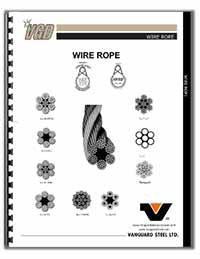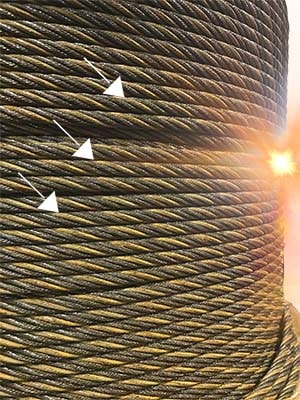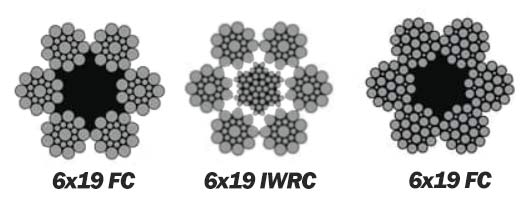

Interactive Booklets
Click on booklet to view content
Wire rope is a type of rope that is made up of multiple strands of wire twisted or braided together. It is typically used in situations that require high strength and durability, such as in cranes, elevators, suspension bridges, and ship rigging.
The individual wires that make up the strands of wire rope can be made from a variety of materials, including steel, stainless steel, and various alloys. The wires are twisted or braided together in a specific pattern to create the final rope, which is then coated with a protective layer to increase its resistance to wear and corrosion.
Wire rope is known for its high tensile strength, flexibility, and resistance to abrasion and fatigue. It is also able to handle heavy loads over long distances without stretching or breaking, making it a popular choice for many industrial and commercial applications


Vanguard's signature "Gold Strand" gives you peace of mind knowing Vanguard has you covered.
The quality of a wire rope is determined by several factors, including the materials used to make the rope, the construction of the rope, and the manufacturing process used to produce it. Here are some factors why Vanguard’s wire ropes better than others:
Material: Wire ropes can be made from different materials, such as steel, stainless steel, or various alloys. The choice of material depends on the intended use of the rope, as well as the environmental conditions it will be exposed to.
Strength: The strength of a wire rope is determined by its diameter and the number of wires it contains. A thicker rope with more wires will generally be stronger than a thinner one.
Flexibility: Wire ropes need to be flexible enough to bend and twist without breaking, but also rigid enough to handle heavy loads. The flexibility of a rope is determined by the size and number of wires used, as well as the way they are twisted or braided together.
Resistance to wear and corrosion: Our wire ropes are coated with a protective layer to increase their resistance to wear and corrosion. The type and quality of the coating can greatly affect the lifespan of the rope.
Manufacturing process: The manufacturing process used to produce a wire rope can affect its quality and durability. Our well-made wire rope will have consistent tension and twist, with no kinks or defects.
Overall, a high-quality wire rope will be made from strong, durable materials and will be constructed and manufactured to withstand the specific conditions of its intended use.


6×19 wire rope is a type of wire rope construction that consists of six strands, each made up of 19 individual wires. The wires in each strand are twisted together in a helical pattern, and the six strands are then laid together in a regular pattern around a core, which can be made of either fiber or steel.
This construction provides a good balance between strength and flexibility, making it a popular choice for a wide range of applications, including lifting, hoisting, and rigging. 6×19 wire rope is often used in cranes, winches, and mining operations, as well as in industrial and marine settings.
The strength and durability of 6×19 wire rope can vary depending on the materials used and the manufacturing process, so it’s important to choose the right type of wire rope for your specific application and operating conditions.
Fibre core wire rope is a type of wire rope that has a core made of natural or synthetic fibres, such as sisal, polypropylene, or high-performance aramid fibres. The fibres are twisted together to form a strong, flexible core that provides additional strength and flexibility to the wire rope.
Fibre core wire rope is commonly used in applications where shock absorption is important, such as in cranes, elevators, and other lifting equipment. The fibres in the core help to absorb shock and reduce the impact of sudden loads or jerky movements, which can help to protect the wire rope from damage and extend its lifespan.
In addition to providing shock absorption, fibre core wire rope also offers other benefits, such as improved bending fatigue resistance, reduced weight, and increased resistance to corrosion and abrasion. The type of fibre used in the core can be selected based on the specific requirements of the application, such as the load capacity, operating temperature, and environmental conditions.
Overall, fibre core wire rope is a versatile and durable option for a wide range of lifting and rigging applications and can provide superior performance and longevity compared to wire rope with a traditional steel core.
Wire core wire rope, also known as independent wire rope core (IWRC) wire rope, is a type of wire rope construction that has a core made of a separate wire rope that is stranded in the opposite direction to the outer strands. The core provides additional strength and resistance to crushing and deformation and can help to improve the fatigue life and overall durability of the wire rope.
The construction of wire core wire rope typically consists of a series of strands made up of individual wires that are twisted together in a helical pattern, which are then laid around the IWRC core. The number of strands and wires in each strand can vary depending on the application and load requirements.
Wirecore wire rope is often used in applications that require high strength, such as in mining, construction, and offshore drilling operations. It is also commonly used in crane and hoist applications, as well as in elevators and other lifting equipment.
Compared to other types of wire rope construction, wire core wire rope offers several advantages, such as improved flexibility, greater resistance to abrasion and corrosion, and higher breaking strength. However, it can also be more expensive and may require more maintenance and inspection to ensure safe and reliable performance.


Steel cable, also known as aircraft cable, is a type of cable made from multiple strands of wire that are twisted together to form a strong, flexible rope. Steel cable is typically made from high-strength, corrosion-resistant materials such as carbon steel, stainless steel, or galvanized steel, and can be constructed using various types of strand and wire configurations, such as 1×7, 7×7, or 7×19.
Steel cable is used in a wide range of applications, including lifting, hoisting, rigging, and anchoring. It is commonly used in construction, mining, and offshore drilling operations, as well as in transportation, such as in cable car systems and suspension bridges. Steel cable is also used in industrial machinery, cranes, and winches, and is often used to secure cargo and equipment in shipping and transportation.
The strength and durability of steel cable depend on factors such as the material used, the strand and wire configuration, and the manufacturing process. Proper installation, inspection, and maintenance of steel cables are important to ensure safe and reliable performance.
Steel cable can offer several advantages over other types of cable, such as high strength-to-weight ratio, good resistance to abrasion and fatigue, and excellent flexibility and bending characteristics. However, it can be susceptible to corrosion, especially in harsh or marine environments, and can be prone to wear and damage over time, which can reduce its overall lifespan.

